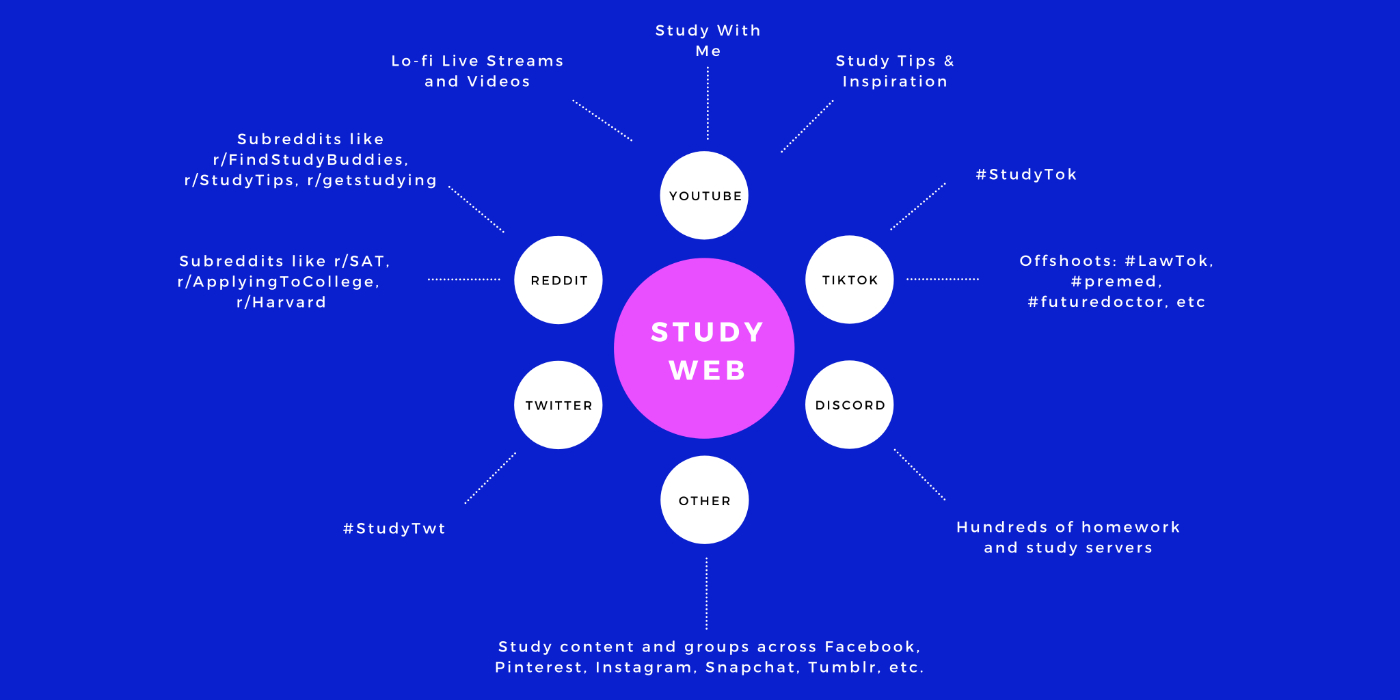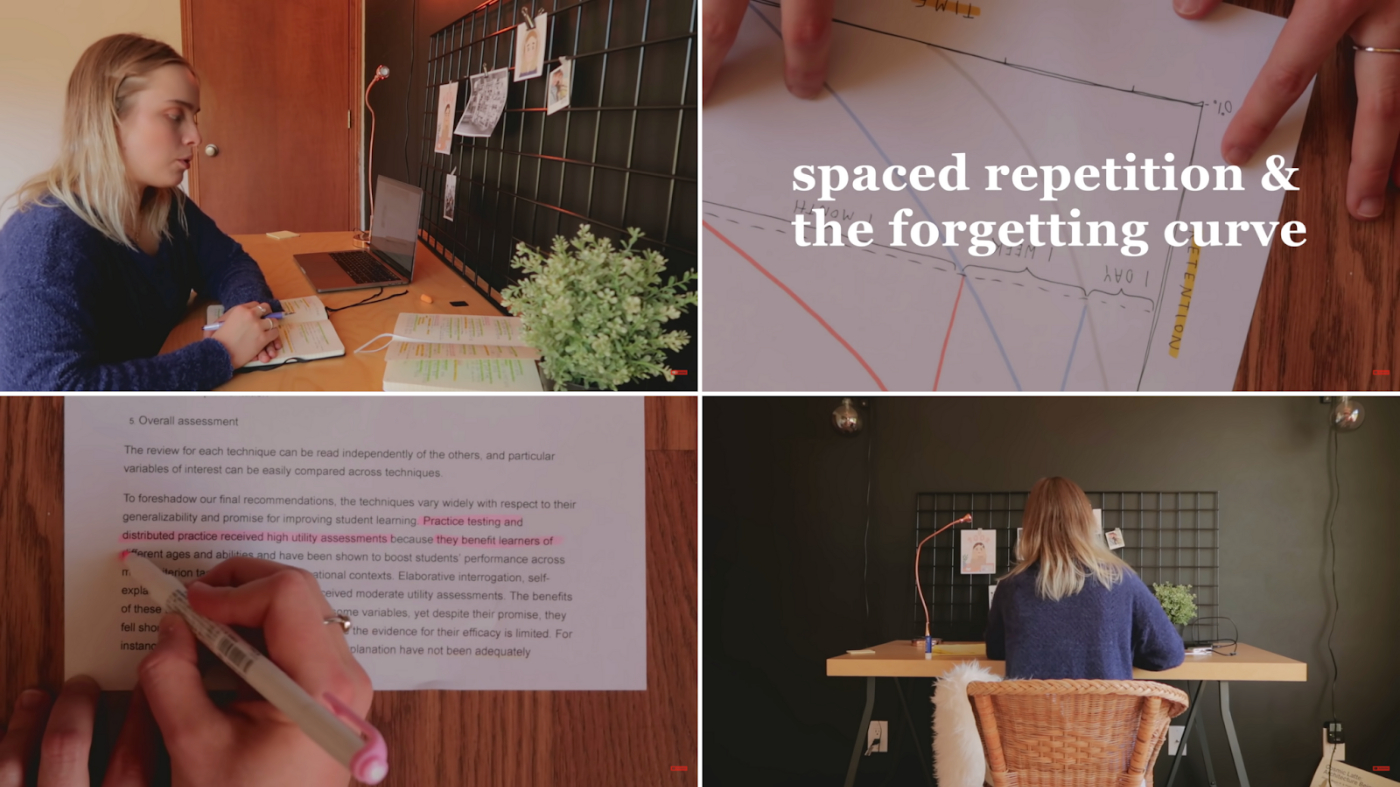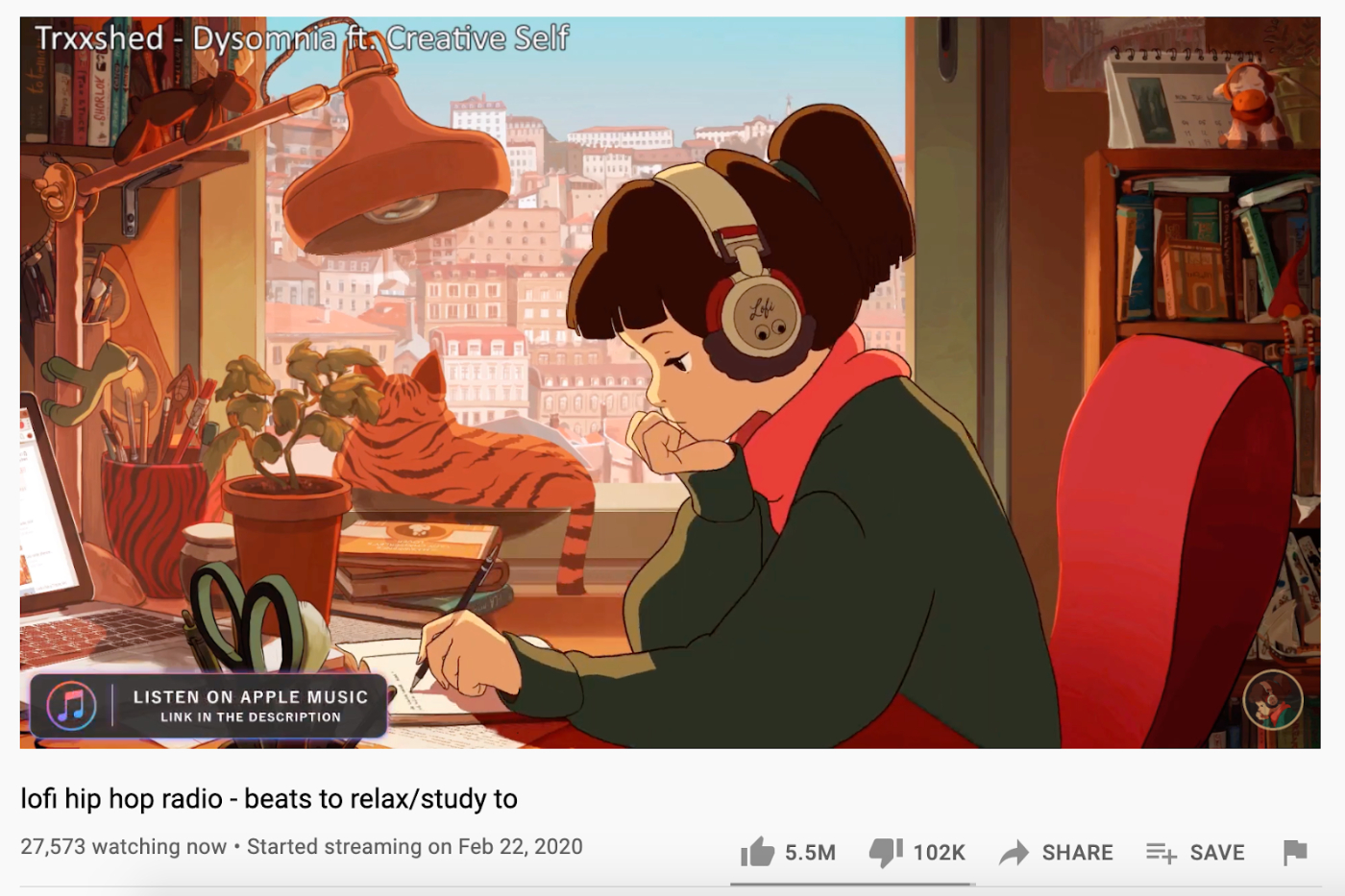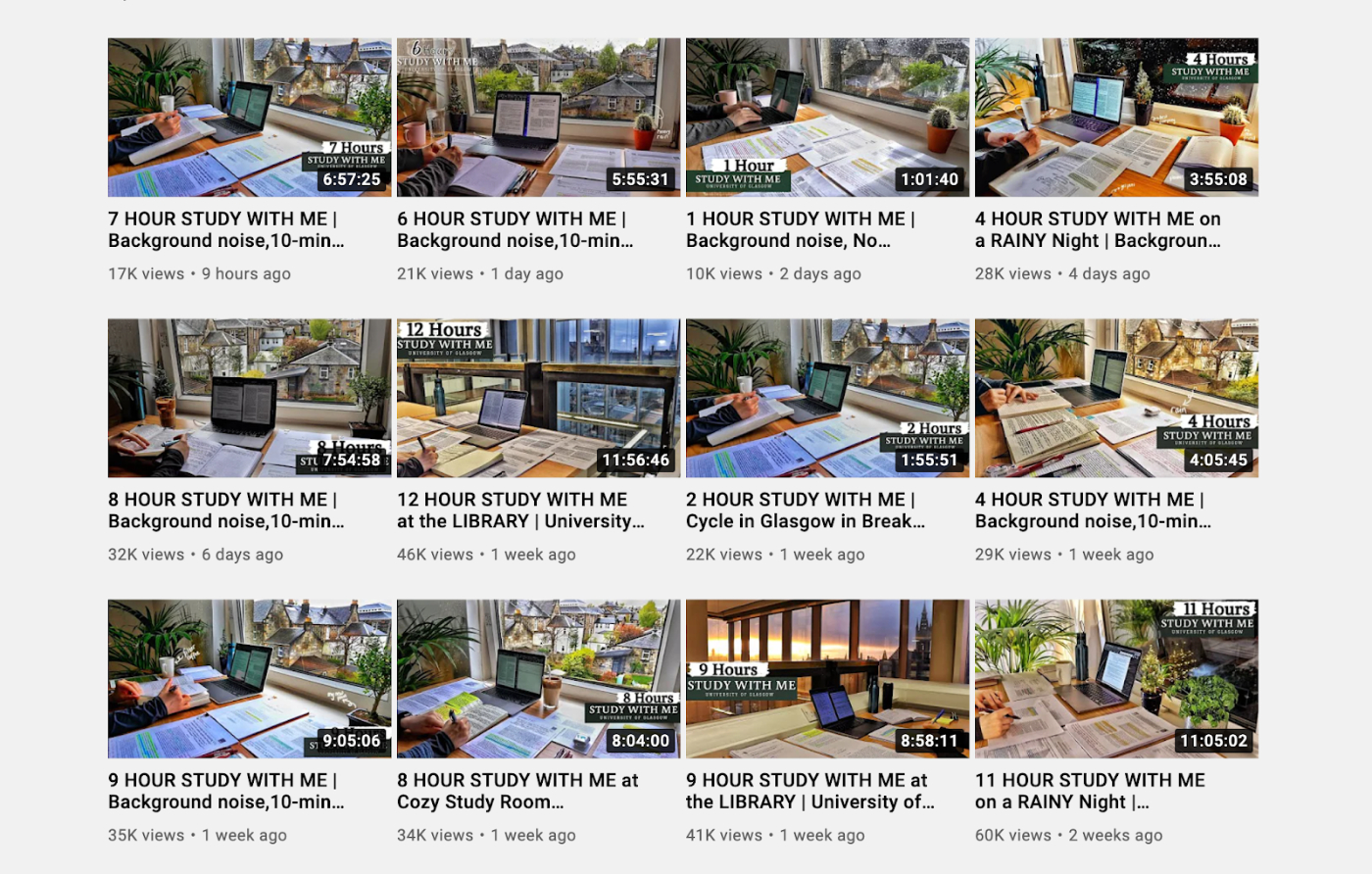
In late 2020, a 10-hour loop of a song from Mario Kart titled “Coconut Mall” started blowing up on Youtube. Initially uploaded as a joke by Gliccit in 2017, the video never saw more than 39 views a day in that calendar year.
But on October 29, 2020, “Coconut Mall” was viewed 39,959 times. As of late April 2021, the video has been played for a collective 478,941 hours. Why did a relatively obscure video featuring a song from 2008 MarioKart Wii get such a significant traffic boost?
The “Coconut Mall” video exploded when it got pulled into what I call Study Web.
Study Web is a vast, interconnected network of study-focused content and gathering spaces for students that spans platforms, disciplines, age groups, and countries. Students seeking motivation, inspiration, focus, and support watch livestreams of a real person at their desk, studying; videos in the Study With Me genre are simultaneously streamed by thousands of students. Or they join Discord communities, where they search for “study buddies,” share studying goals, and compete—by studying—for virtual rewards. On Twitter, they swap study tips and seek out study “moots,” or mutuals, under the hashtag #StudyTwit.
In the case of the “Coconut Mall” video, a TikTok study influencer recommended the video as great focus music, under the hashtag #StudyTok. Tens of thousands flocked to watch, chat, and, of course, study:
- “I'm back again because I have a big test to study for, a bunch of busy work due tomorrow, and graphing math homework. Here we go.”
- “POV: you waited too long to do that big project so you are rushing to finish knowing that you will fail regardless”
- “just wrote 3 essays and took 2 quizzes listening to this... thank god for coconut mall.”
The Study Web is a constellation of digital spaces and online communities—across YouTube, TikTok, Reddit, Discord, and Twitter—largely built by students for students. Videos under the #StudyTok hashtag have been viewed over half a billion times. One Discord server, Study Together, has over 120 thousand members. Study Web extends far past study groups composed of classmates, institution specific associations, or poorly designed retro forums discussing entrance requirements for professional programs. It includes but transcends Studyblrs on Tumblr that emerged in 2014 and eclipses various Reddit and Facebook study groups or inspirational images shared across Pinterest and Instagram. Populated mostly by Gen Z and the youngest of millennials, Study Web is the internet most of us don’t see, and it’s become a lifeline for students from junior high to college.
Much of Study Web parallels more adult and professional spaces that have emerged in the last decade—revered influencers, a bend towards materialism, and inspiration over analysis. But it’s also a reflection of the realities of young people today that most of us miss.
Why are millions of students from around the world spending countless hours online, tangled in the Study Web of their own design?
In the highly-pressurized pursuit of the academic goals they’ve been told will help them succeed, students venture into Study Web to feel less alone; assuaging anxiety with inspiration, pursuing perfect grades through para-social productivity, and quelling fears about the future with cyber friends. As Zoom school has left young people even more desperate for connection and support, they’re turning to Study Web—post-to-post, DM-to-DM, and webcam-to-webcam—to find it.
I dove into Study Web to see how it works.
YouTube
If you’re a mid-millennial or older, and once-upon-a-time used YouTube for studying and learning course material, you might remember Khan Academy videos explaining the Krebs cycle or a kind stranger from India balancing redox equations.
These tutoring style videos are generally one-off watches where students land to grasp a concept and rarely return. While they exist in the same universe, they feel worlds apart from the fresher crop of content on the YouTube section of Study Web where students return again and again, seeking comfort and counsel from their favorite creators, regardless of what they’re studying or where they go to school.
Study Creators
Every online world, from Tech Twitter to Linkedin, has its influencers—Study Web is no exception. On YouTube, study creators with thousands to millions of subscribers focus less on subject matter and curriculum, instead sharing productivity tactics and study techniques. A key feature of these videos is aesthetics—from the right ruler to the perfect pen. Lighting is an important part of a study creator’s vibe: candles, string lights, salt lamps, and neon lights are all common fare. Most creators are students themselves, grappling with many of the same pressures that they’re guiding their audience through — namely, a seemingly endless workload and a schooling system that drives youth to equate academic achievement with self-worth.
On her YouTube channel The Bliss Bean, a creator named Beatrice provides advice on leveraging active recall and using Anki for spaced repetition (a different digital flash card tool is the video’s paid sponsor). A student herself, she imparts the importance of effective study habits:
“...instead if you set yourself little goals, if you set yourself little time limits and you implement techniques to help you get stuff done within those time limits, then you will win at school and at life.”
Another study influencer, Berkeley student Angelica Song recommends finding an effective note-taking system and staying off your phone during long classes. She lends advice on how to think about the much coveted student goal, straight A’s:
“...yes grades are not everything. GPA is not everything. I know that. But sadly a lot of the industry still today heavily rely on what grades you get: medical school, law school, grad school. And so it is important that you kind of do the best or like, win the game in the system in this academic and educational institutional ecosystem thing we have going on. We have to win the simulation! We're all in this simulation and then we have to win it.”
This emphasis on “winning” the game of exams and assignments leaves out the implicit idea that doing poorly is to lose—to be a loser—and not just at school. Luckily, the right study tip or academic advice is just a recommended watch away. YouTube’s content in the genre seems endless: videos on setting up your workspace, the science behind active recall, and how to implement memorization tricks like the mind palace. There are techniques taught on how to focus with pomodoros or how to create a study schedule. 10 hacks to get a 4.0, study tips from a college graduate, and brutally honest advice on getting good grades. The comments from students surfing the Study Web under these videos reveals a mix of gratitude, hope, and anxiety:
- “I’m failing class so this helped me extremely good ty ❤️”
- “does anyone just gets anxious when a video writes ‘study smarter, not harder’ and end up watching it eventhough its the same technique? just me?”
- “Thank you so much for making this wonderful video! I’ve been struggling with my grades now a days and I think this would really help me!”
Lo-fi + Live Streams
Students aiming to move past aspiration can use one of the oft recommended techniques to actually study: the right music, specifically lo-fi. Lo-fi, or “low fidelity,” music is under-produced; it feels warm, calming, and homemade, demanding little attention or active listening, making it a go-to for studiers.
One evening, I navigated to a frequently mentioned study tool, Lofi Girl, a music YouTube channel with 8.4M subscribers, and selected a video titled "lofi hip hop radio - beats to relax/study to." I was plugged into Study Web. Joining me were 38,892 other live users, listening along. I peered at the chat that was moving too quickly to follow:
- “What grade is everyone in?”
- “Can’t wait for algebra to be over!”
- “Anyone speak Russian?”
- “Home School cause of Corona”
- “today i failed the exame, i'm depressed”
Started in 2017 as “Chilled Cow,” Lofi Girl is one of the most popular focus music channels on YouTube. Aside from community members leaving comments on live streams, the Lofi Girl brand includes a study Discord server with over 500K members, playlists on Spotify and Apple Music, a Subreddit, and social media profiles across most major platforms. Whether or not lo-fi music truly helps you study better is debatable, but the science is largely irrelevant to the tens of thousands of listeners who join live streams each day to hear hours-long mixes of different artists evoking a similar sound: a blend of bland, chill, premium mediocre.
Lofi Girl is one of the largest YouTube channels where students congregate in the comments, but it’s one of many. An hour-long lo-fi mix, homework & study, which intermixes dialogue from the series finale of Friends (“This is harder than I thought it would be”) and Casablanca (“Some of the old songs, Sam”), has 19.5 millions views and a steady stream of students studying:
- “i cannot express how much i hate school rn.”
- “i literally have 10 more missing assignments. im done with this.”
- “got a week left for the school year. let's do our best!”
Study With Me
For students who want to get even closer to the feeling of virtual company, there’s a genre of Study Web videos that provide a parasocial pairing: “Study With Me” or “Gongbang” as they’re called in South Korea, where they’re also quite popular. Often streamed live on YouTube or Twitch, creators sit at their desks and study, the idea being that fellow students watching will open up their textbooks and laptops to study alongside them. These videos simulate the feeling of being in a coffee shop or studying at the library, while also motivating students to focus for extended periods of time.
Creators frequently work in pomodoros, a popular study method that includes a 25-minute study session with 5-minute breaks—though many follow 50:10 or 45:15. Some study without music, though many study with the signature Study Web lo-fi beats or the simulated sound of rain (nature is the original lo-fi creator). A timer counts down to a break in a corner on the screen, and breaks often involve YouTubers going offscreen, prompting students to take breaks too. These videos can be anywhere from 1 hour to 12 hours.
Study With Me creators often have immaculate study surfaces, illuminated by natural light from a nearby window or the soft glow of candlelight: colored flash cards in neat rows, highlighters in sequence, textbook angled and opened, a computer screen with distractions-banished, printed-off readings in organized stacks. On shorter streams, they’ll start with a cup of hot coffee, the steam whips captured on camera, that they sip and eventually finish. If you want to shop their aesthetic you’re in luck: creators include affiliate links in the description, pointing to their specific brand of MUJI pens, Dell 27" 4K Monitor, or Jihe Pocket iPad case. The allure is not only that you can study with your favorite creator, but study like them, buying all their favorite study gadgets and gizmos.
While there are similarities across Study With Me streams, each creator brings their own unique taste to the genre. Merve, an International Relations student at the University of Glasgow, has over 14 million views across her videos. Her audience has never seen her face; she studies off screen, the camera pointed at her desk and monitor, the window in front of her showing the picturesque rooftops of a Glasgow neighbourhood.
Over email, I asked Merve why so many students are drawn to her videos:
“Many students are struggling to find the motivation to study alone in lockdown and they want company to study, to keep them motivated during these unending pandemic days. The majority of the courses are online, and most people are studying or working from home, alone. We are longing for the good old times when we could fill in the classrooms, learn together, study together, laugh and worry together. I think people who are watching my videos are filling this gap by virtually meeting with fellow students from all around the world. They come together in a specific time slot to study together or they open a pre-recorded video to increase their motivation and concentration. Moreover, many of them encourage each other to study harder, not to lose motivation even though they have not and, most probably, will never meet in real life.”
James Scholz, another popular study influencer on YouTube, wins when it comes to the length and consistency of his Study With Me videos. Scholz, an undergraduate at the University of Utah, has streamed 12 hours each day for a year (begging comparisons, at least from my editor, to Jenny Ringley).
Jimmy Kang, a medical student in Canada, streams Study With Me videos ranging from two to 12 hours on his YouTube channel MDprospect. In most videos, Kang faces a screen, while a second monitor displays his work to the viewer. Kang’s digital-centric method contrasts from the analog aesthetics of most Study With Me creators, and it has its own appeal. As one commenter put it: “I love how he has a 2nd screen that shows that he's not procrastinating.” He’s really there, doing the work along with you. In one 3 hour late-night stream, you can see the moon move across the night sky.
The Only Subscription
You Need to
Stay at the
Edge of AI
The essential toolkit for those shaping the future
"This might be the best value you
can get from an AI subscription."
- Jay S.
Join 100,000+ leaders, builders, and innovators

Email address
Already have an account? Sign in
What is included in a subscription?
Daily insights from AI pioneers + early access to powerful AI tools













Comments
Don't have an account? Sign up!
Excellent article!
This is one of the most well-written articles that I have read in the last years. thank you.
Great read! Definitely something I would've loved as a student 😩
Great, engaging article about this community. It makes sense that this would be a thing in the current climate (greater adoption of online teaching and collective pandemic anxiety) but I didn't "see" it. You've made it more tangible!